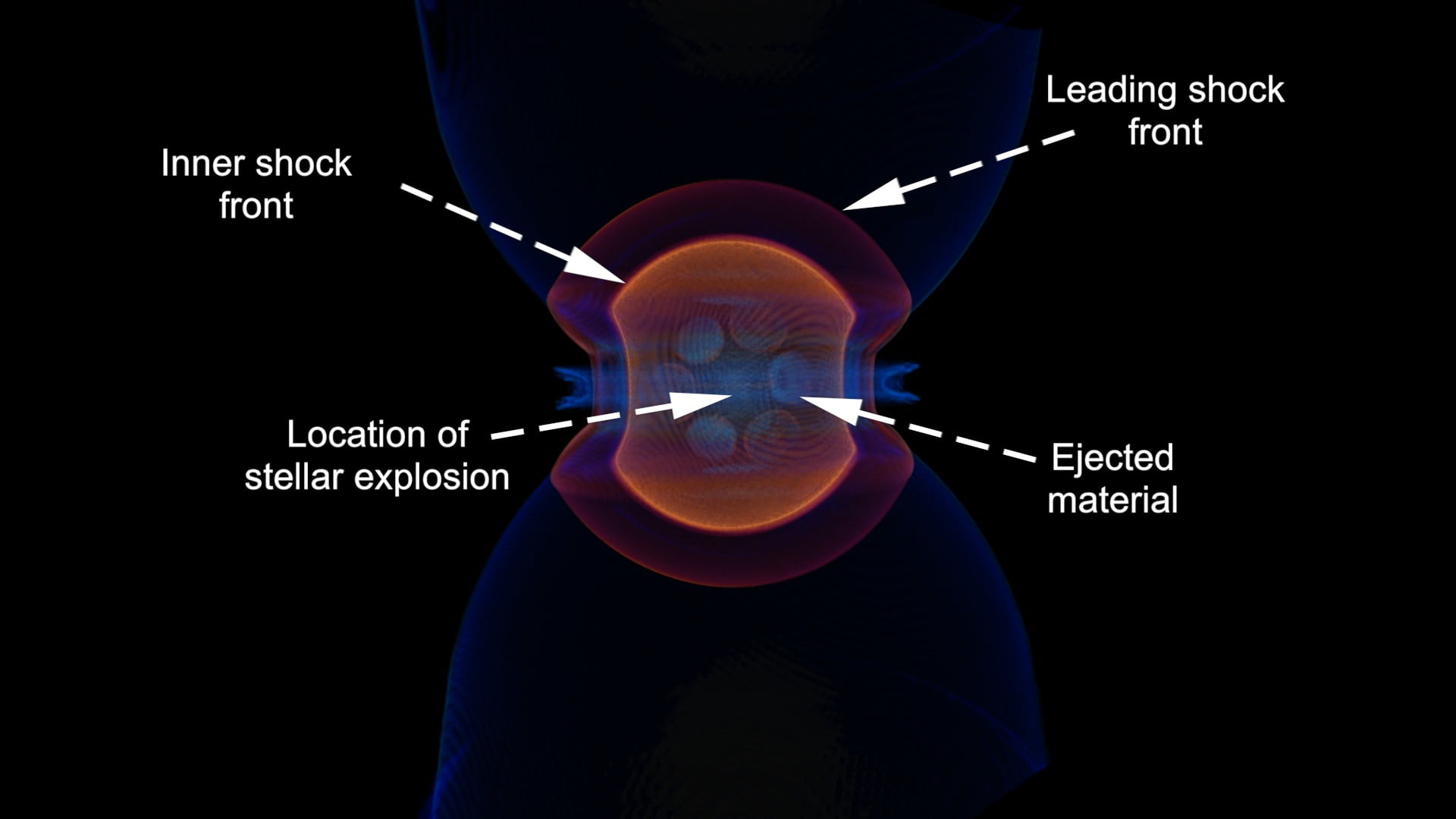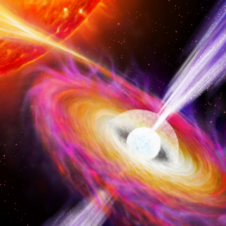In research published today in the Astrophysical Journal, an Australian led team of astronomers has used radio telescopes in Australia and Chile to see inside the remains of a supernova.
The supernova, known as SN1987A, was first seen by observers in the Southern Hemisphere in 1987 when a giant star suddenly exploded at the edge of a nearby dwarf galaxy called the Large Magellanic Cloud.
In the two and a half decades since then the remnant of Supernova 1987A has continued to be a focus for researchers the world over, providing a wealth of information about one of the Universe’s most extreme events.
PhD Candidate Giovanna Zanardo at The University of Western Australia node of the International Centre for Radio Astronomy Research led the team that used the Atacama Large Millimetre/submillimeter Array (ALMA) in Chile’s Atacama Desert and the Australia Telescope Compact Array (ATCA) in New South Wales to observe the remnant at wavelengths spanning the radio to the far infrared.
“By combining observations from the two telescopes we’ve been able to distinguish radiation being emitted by the supernova’s expanding shock wave from the radiation caused by dust forming in the inner regions of the remnant,” said Giovanna Zanardo of the International Centre for Radio Astronomy Research (ICRAR) in Perth, Western Australia.
In an effort to solve this puzzle, Dr Toby Potter, another researcher from ICRAR’s UWA node has developed a detailed three-dimensional simulation of the expanding supernova shockwave.
“By introducing asymmetry into the explosion and adjusting the gas properties of the surrounding environment, we were able to reproduce a number of observed features from the real supernova such as the persistent one-sidedness in the radio images”, said Dr Toby Potter.
The time evolving model shows that the eastern (left) side of the expanding shock front expands more quickly than the other side, and generates more radio emission than its weaker counterpart. This effect becomes even more apparent as the shock collides into the equatorial ring, as observed in Hubble Space Telescope images of the supernova.
“Our simulation predicts that over time the faster shock will move beyond the ring first. When this happens, the lop-sidedness of radio asymmetry is expected to be reduced and may even swap sides.”
“The fact that the model matches the observations so well means that we now have a good handle on the physics of the expanding remnant and are beginning to understand the composition of the environment surrounding the supernova – which is a big piece of the puzzle solved in terms of how the remnant of SN1987A formed.”
“This is important because it means we’re able to separate out the different types of emission we’re seeing and look for signs of a new object which may have formed when the star’s core collapsed. It’s like doing a forensic investigation into the death of a star.”
“Our observations with the ATCA and ALMA radio telescopes have shown signs of something never seen before, located at the centre or the remnant. It could be a pulsar wind nebula, driven by the spinning neutron star, or pulsar, which astronomers have been searching for since 1987. It’s amazing that only now, with large telescopes like ALMA and the upgraded ATCA, we can peek through the bulk of debris ejected when the star exploded and see what’s hiding underneath.”
Further Information:
ICRAR is a joint venture between Curtin University and The University of Western Australia with support and funding from the State Government of Western Australia.
Original publication details:
‘Spectral and Morphological Analysis of the Remnant of Supernova 1987a with ALMA & ATCA’ G. Zanardo, L. Staveley-Smith, R. Indebetouw et al. Published in the in the Astrophysical Journal November 10th, 2014. Pre-print paper available at:http://arxiv.org/abs/1409.7811 and http://iopscience.iop.org/0004-637X/796/2/82 after 8am EST, November 10th.
‘Multi-dimensional simulations of the expanding supernova remnant SN 1987a’ T.M Potter, L Staveley-Smith, B. Reville et al. Published in the Astrophysical Journal October 20th, 2014. Available at http://arxiv.org/abs/1409.4068 and http://iopscience.iop.org/0004-637X/794/2/174.
Contact Details:
Dr Giovana Zanardo, ICRAR – UWA
Ph: +61 8 6488 7765 | M: +61 414 531 081 | E: Giovanna.Zanardo@gmail.com
Professor Lister Staveley-Smith, ICRAR Science Director – UWA
Ph: +61 8 6488 4550 | M: +61 425 212 592 | E: Lister.Staveley-smith@icrar.org
Pete Wheeler, ICRAR Media Contact
Ph: +61 8 6488 7771 | M: +61 423 982 018 | E: Pete.Wheeler@icrar.org
David Stacey, UWA Media Manager
Ph: +61 8 6488 7977 | E: David.Stacey@uwa.edu.au
Supporting Multimedia:
The animation and images below are all available for download.
A video compilation showing Supernova Remnant 1987A as seen by the Hubble Space Telescope in 2010, and by radio telescopes located in Australia and Chile in 2012. The piece ends with a computer generated visualisation of the remnant showing the possible location of a Pulsar.
A visualisation showing how Supernova1987A evolves between May of 1989 and July of 2014. Credit: Dr Toby Potter, ICRAR-UWA, Dr Rick Newton, ICRAR-UWA
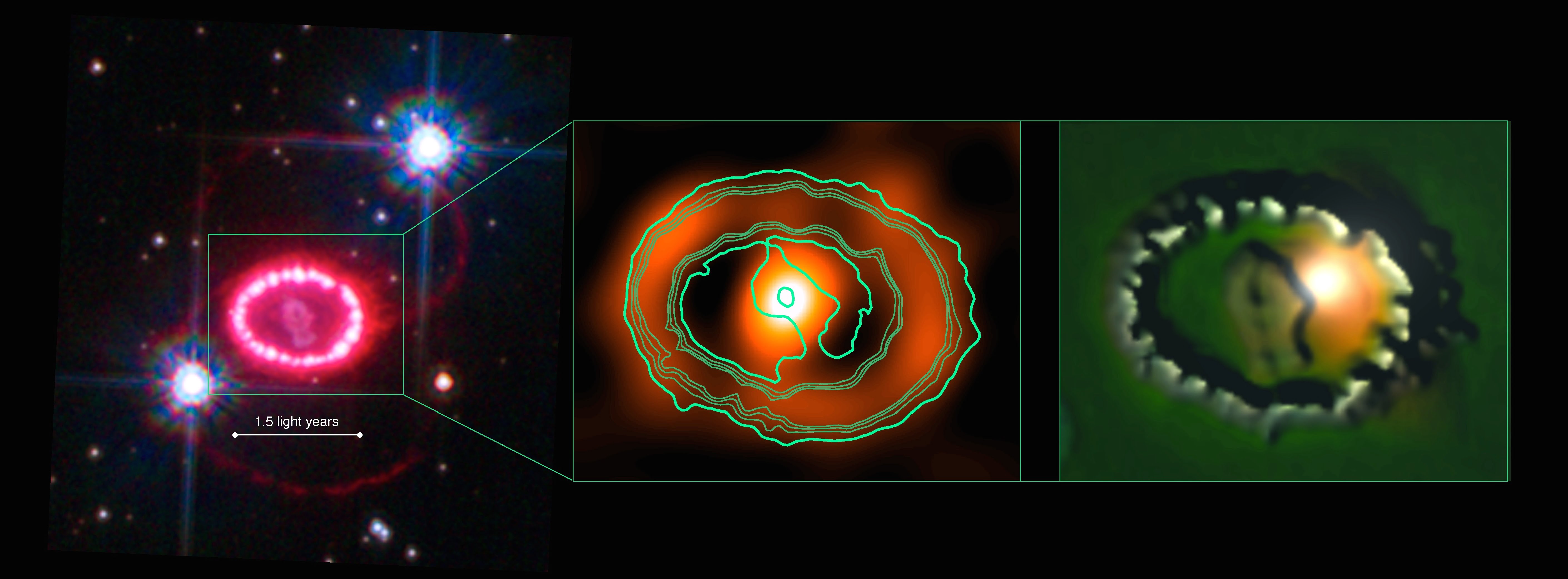
A panel of images showing different views of Supernova Remnant 1987A.
Left Panel: SNR1987A as seen by the Hubble Space Telescope in 2010.Middle Panel: SNR1987A as seen by the Australia Telescope Compact Array (ATCA) in New South Wales and the Atacama Large Millimeter/submillimeter Array (ALMA) in Chile. Right Panel: A computer generated visualisation of the remnant showing the possible location of a Pulsar.
Credit: ATCA & ALMA Observations & data – G. Zanardo et al. / HST Image: NASA, ESA, K. France (University of Colorado, Boulder), P. Challis and R. Kirshner (Harvard-Smithsonian Center for Astrophysics)
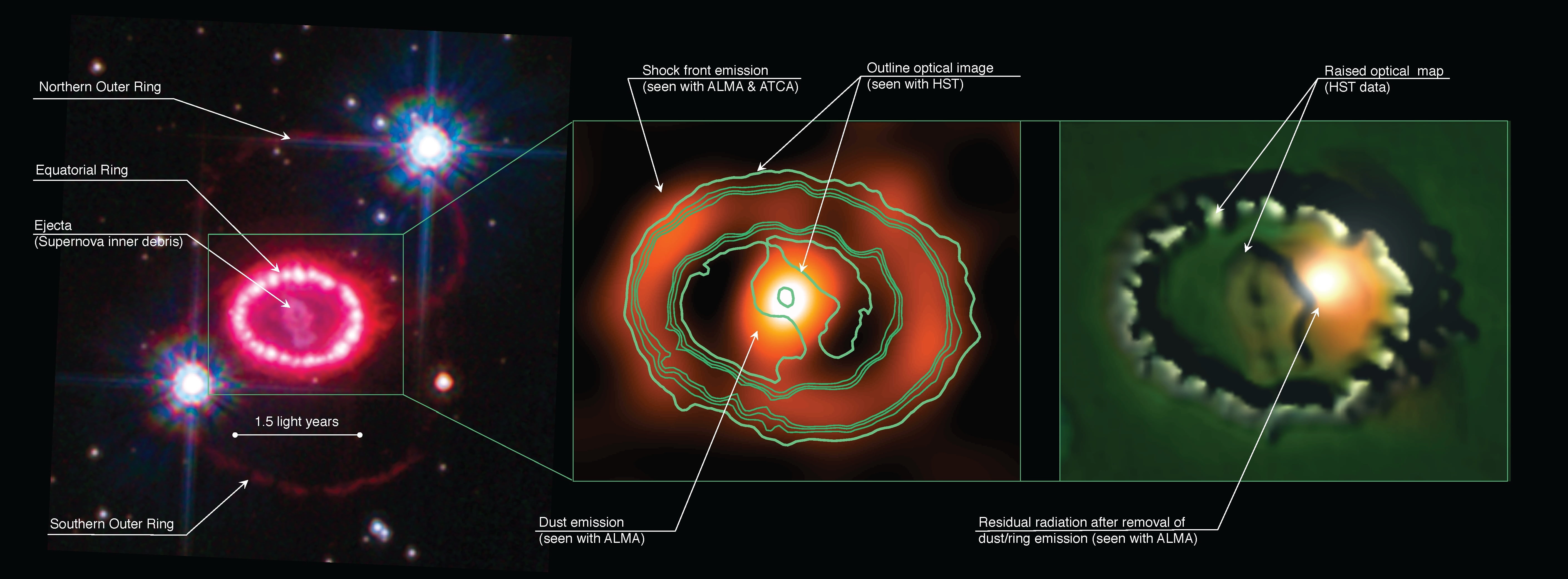
A labeled panel of images showing different views of Supernova Remnant 1987A.
Left Panel: SNR1987A as seen by the Hubble Space Telescope in 2010.Middle Panel: SNR1987A as seen by the Australia Telescope Compact Array (ATCA) in New South Wales and the Atacama Large Millimeter/submillimeter Array (ALMA) in Chile. Right Panel: A computer generated visualisation of the remnant showing the possible location of a Pulsar.
Credit: ATCA & ALMA Observations & data – G. Zanardo et al. / HST Image: NASA, ESA, K. France (University of Colorado, Boulder), P. Challis and R. Kirshner (Harvard-Smithsonian Center for Astrophysics)
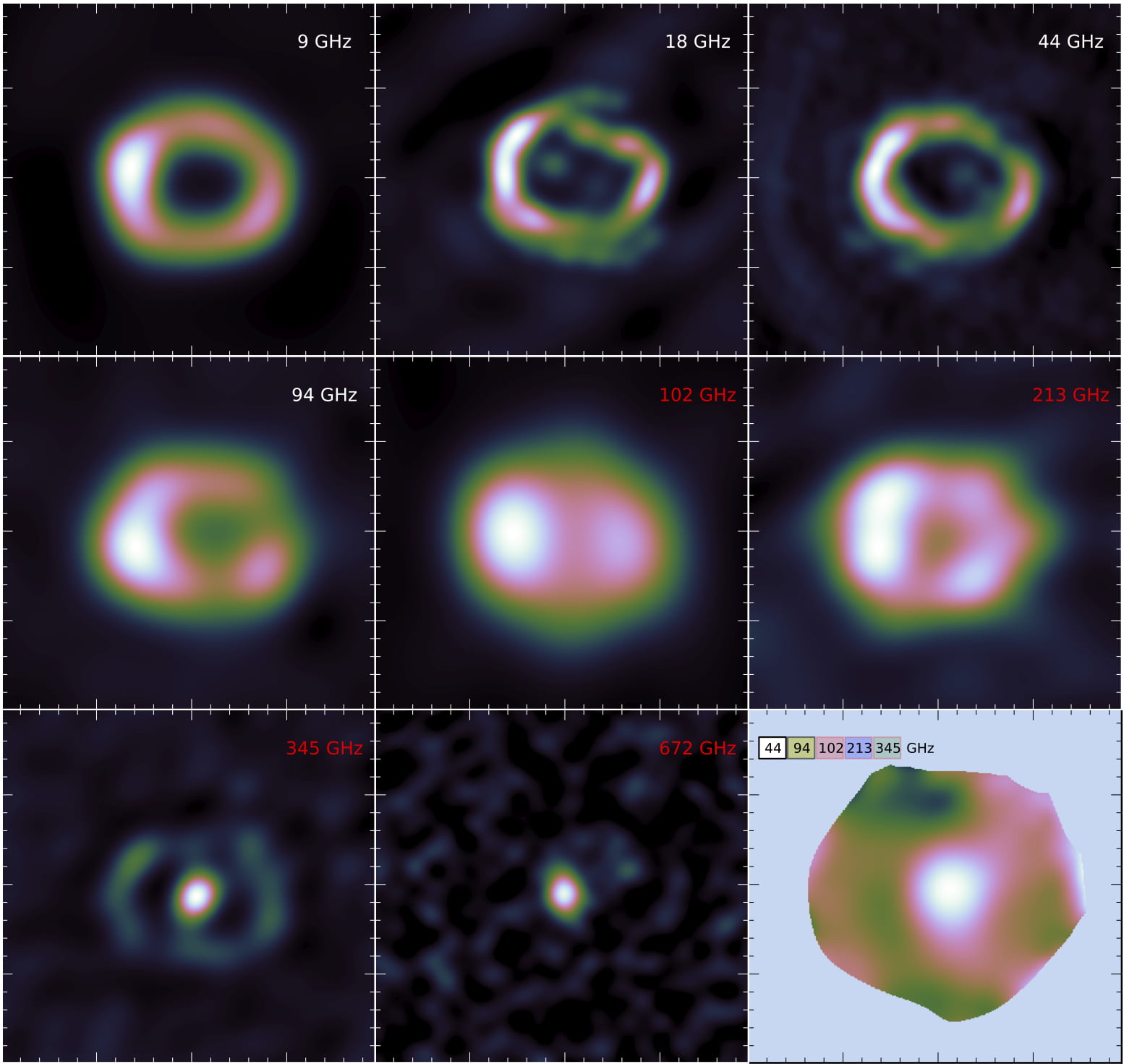
A mosaic of images showing the latest observations of Supernova remnant 1987A at radio frequencies to the far infrared.
Images below 100 GHz are from observations made with the ATCA telescope (NSW, Australia), and images above 100 GHz are from the ALMA telescope (Chile). The map on the bottom right of the mosaic is obtained by combining five images. This is used to investigate whether there is a pulsar wind nebula inside the remnant.
Credit: G. Zanardo, ICRAR-UWA
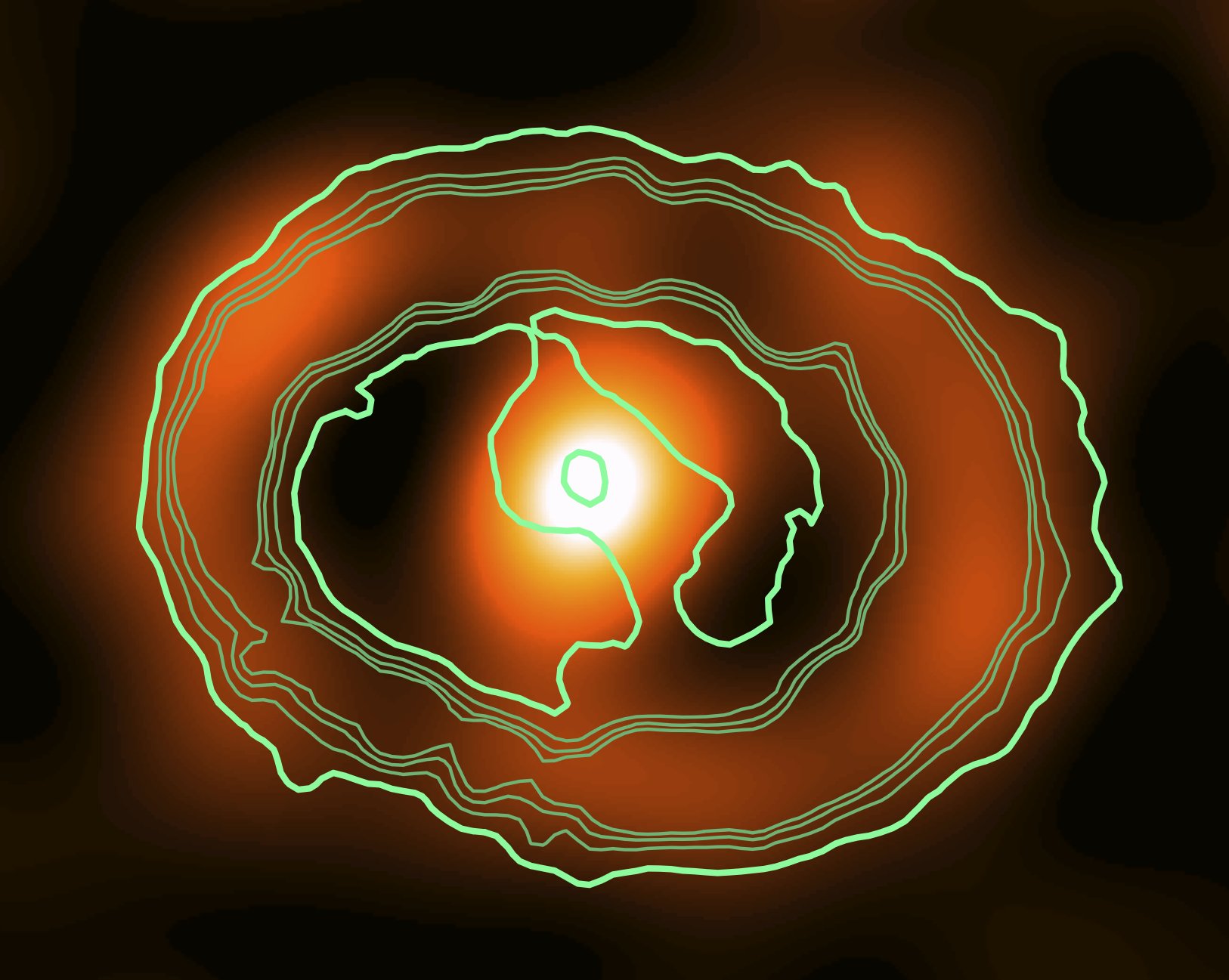
An outline of the equatorial ring and inner debris, as seen with the Hubble Space Telescope (green/blue contours), on top of ALMA observations of the remnant at 345 GHz (red/orange, with rendering).
Credit: G. Zanardo, ICRAR-UWA
